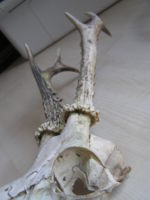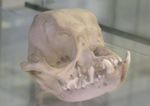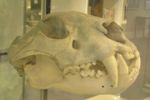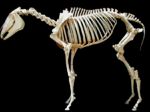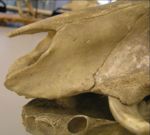Skull and Facial Muscles - Anatomy & Physiology
Introduction
The shape and size of the skull varies widely, not only between species but also with age, breed and sex of similar species. The skull is divided into three components- the neurocranium, the dermatocranium and the viscerocranium. The skull also includes the hyoid apparatus, mandible, ossicles of the middle ear and the cartilage of the larynx, nose and ear. The skull protects the brain and head against injury and supports the structures of the face. In some animals the skull is also used for defensive actions, for example in horned ungulates such as red deer stags.
The neurocranium develops from the neural crest and mesoderm and undergoes endochondral ossification. It lies ventral to the brain.
The dermatocranium lies dorsal to the brain and develops from the neural crest and mesoderm. It undergoes intramembranous ossification.
The viscerocranium is the pharyngeal skeleton. It is derived only from the neural crest and undergoes endochondral and intramembranous ossification.
The various facial muscles attach onto the skull in different places depending on their function. Movement of the external apendages, mastication and facial expressions all rely on the movement of the facial muscles.
Structure
- The skull is made of many smaller bones
- Most of the skull bones are paired
- Cartilage or fibrous tissue separates the bones of the skull in the young animal
- Once growth has ceased, the sutures begin to ossify
Function
- Protection of brain
- Support facial muscles by providing origin and insertion sites
- Foramen provide entry and exit places for the vasculature and nervous system
- Defense
Bones of the Skull
Occipital Bone (os occipitale)
- Forms the nuchal wall
- Forms the foramen magnum
- Basilar part (pars basilaris)
- Caudal base of the cranium
- Rostral to foramen magnum
- Joined by cartilagenous suture to basisphenoid bone
- Muscular tubercules on ventral surface where the flexors of the head and neck attach
- Caudal cranial fossa enclose the pons and medulla oblongata
- Squamous part (pars squamosa)
- Dorsal to lateral parts and occipital condyles
- Nuchal crest present
- Easily palpable
- Landmark for collection of cerebrospinal fluid (CSF)
- External occipital protuberances present which provide muscle attachment sites for the nuchal ligament
- Lateral parts (partes laterales)
- Lateral borders of foramen magnum
- Occipital condyles present which articulate with the atlas to form the atlanto-occipital joint
- Paracondylar process present which provides muscle attachment sights for muscles of the head
- Hypoglossal canal
Sphenoid Bone (os sphenoidale)
- Forms the base of the neurocranium
- Composed of a body and wings
- Bones separated by cartilage which ossifies with age
- Presphenoid (os praespenoidale)
- Rostrally
- Rostral caudal fossa
- Hollow body with sphenoid sinuses located inside
- Sphenoid rostrum present
- Optic chiasma
- Optic Canal
- Basisphenoid (os basispenoidalis)
- Caudally
- Median cranial fossa
- The wings oppose the temporal bone, maxilla, orbit and the brain
- Wings form the oval foramen and other foramen (see species differences) carotid notch, oval foramen and spinous notch (in the horse)
- Pterygoid processes present
- Alar canal (rostral and caudal alar foramen)
Temporal Bone (os temporale)
- Composed of squamous, petrosal and tympanic parts
- Lateral wall of the cranial cavity
- Articulates with the frontal, pareital and sphenoid bones
- Zygomatic process
- On squamous part
- Joins the temporal process of the zygomatic bone to form the zygomatic arch
- Forms the articulating surface of the temperomandibular joint
- Articular tubercle present
- Mandibular fossa present
- Occipital process and retrotympanic process surrounds the external acoustic meatus
- Petrosal part encloses the inner ear
- Internal acoustic meatus present
- Forms mastoid process ventrally
- Styloid process present which attaches the hyoid apparatus
- Stylomastoid foramen present
- Tympanic part is the ventral section of the temporal bone
- Tympanic bulla present
- Tympanic membrane separates tympanic cavity from external acoustic meatus
- Encloses auditory ossicle dorsally
- Musculotubal canal where tensors of the soft palate originate
Frontal Bone (os frontale)
- Paired
- Joined by the interfrontal suture
- Between the cranium and the face
- Encloses the frontal sinuses
- The nasal and lacrimal bones border the frontal squama section
- Forms the zygomatic process laterally
- Forms the dorsal part of the orbit
- Lacrimal gland present
- Temporal line present which extends into the external sagittal crest
- Cornual processes in horned ruminants
- The nasal section is the rostral part of the frontal bone
- Orbital part is perforated by the ethmoidal foramen
- Medially the dorsal oblique muscle of the eyeball attaches
- Temporal part provides the muscle attachments for the temporalis muscle
Parietal Bone (os parietale)
- Paired
- Forms the dorsolateral wall of the cranium
- Occipital bone caudally
- Frontal bone rostrally
- Composed of a pareital plane, temporal plane and a nuchal plane (in the ox)
- Internally the grooves and ridges correspond with the gyri and sulci of the brain
- Interpareital bone between the occipital bone and the pareital bone
- Fuses with age
Ethmoid Bone (os ethmoidale)
Nasal Bone (os nasale)
- Paired
- Forms the roof of the nasal cavity
- Dorsal nasal conchae attach to the ethmoidal crest on the internal surface
- Rostral suture form the apex
- Between the nasal and incisive bones is the nasoincisive notch
Lacrimal Bone (os lacrimale)
- Forms part of the lateral wall of the face and orbit
- Situated near the medial canthus
- It articulates with the frontal bone, zygomatic bone and maxilla
- Also articulates with the nasal bone in ruminants and the horse
- Also articulates with the palatine bone in carnivores
- Composed of an orbital and facial part separated by supra- and infraorbital margins
- The nasolacrimal duct is present by the margin of the orbital surface
- Ventral oblique muscle attaches caudal to the margin of the orbital surface
- Nasal surface forms the boundaries of the maxillary and frontal sinuses
Zygomatic Bone (os zygomaticum)
- Lateral and ventral to the lacrimal bone
- Forms the orbit and zygomatic arch
- Supraorbital margin formed by the zygomatic process of the temporal bone and the frontal process of the zygomatic bone
- Facial crest present on lateral surface
Incisive Bone (os incisivium)
- Paired
- Composed of body, nasal, palatine and alveolar parts
- Joins with the maxilla to form the interalveolar margin
- Forms the rostral part of the facial section of the skull, the roof of the hard palate and the opening to the nasal cavity
- The alveolar process form conical sockets for the incisor teeth
Palatine Bone (os palatinum)
- Paired
- Between the maxilla, sphenoid and pterygoid bones
- Composed of a horizontal plate (forms part of the hard palate), perpendicular plate (forms the dorsal and lateral walls of the nasopharyngeal meatus) and the choanae
- Nasal crest present on the horizontal plate
- Palatine sinus present on horizontal plate
Vomer
- Unpaired
- Extends from the choanae of the palatine bone to the floor of the nasal cavity
- Attavhes to the median nuchal crest
- Septal sulcus formed which surrounds nasal cavity
Pterygoid Bone (os pterygoideum)
- Paired
- Bordered by the palatine and sphenoid bones
- Forms dorsal and lateral walls of the nasopharyngeal cavity
- Pterygoid hamulus present
Maxilla
Mandible (mandibula)
Major Foramen and Canals
- Jugular Foramen
- Foramen Magnum
- Formed by occipital bones
- Spinal cord's passage to the neck and body
- Alar ligaments run through
- Vertebral arteries run through
- Spinal arteries run through
- Tectoral membranes run through
- Hypoglossal Canal
- Between paracondylar and condylar processes on lateral part of occipital bone
- Hypoglossal nerve (CN XII)
- Condylar artery and vein
- Optic Chiasma
- Runs in transverse depression behind sphenoid rostrum on presphenoid bone
- Path of the optic nerve (CN II)
- Optic Canal
- Ends from optic chiasma over wings of the presphenoid bones
- Optic nerve (CN II)
- Oval Foramen
- Caudal wing of the basisphenoid bones
- Mandibular branch of the trigeminal nerve (CN V3)
- Alar Canal
- Rostral border of the basisphenoid bone at the base of the pterygoid processes
- Composed of the caudal alar foramen, rostral alar foramen and the small alar foramen
- Maxillary branch of the trigeminal nerve (CN V2)
- Temporal artery
- Stylomastoid Foramen
- Situated on the petrosal part of the temporal bone
- Facial nerve (CN VII)
- Ethmoidal Foramen
- Perforate the orbital part of the frontal bone
- Olfactory nerve (CN I)
- Ethmoidal artery and vein
- Palatine Canal
- Runs through horizontal plate of palatine bone
- Palatine artery
- Palatine vein
- Palatine nerves
- Internal Acoustic Meatus
Species Differences
Canine
- Dogs have different skull lengths depending on breed
- Mesocephalic dogs have average conformation
- Dolichocephalic dogs have longer skull lengths
- Brachycephalic dogs have shorter skull lengths
- 2 halves of the mandible do not fuse allowing some movement
- External sagittal crest arises from nuchal crest
- Wings of the basisphenoid bones form the oval foramen, spinous foramen and carotid canal
- No foramen lacernum
- Styloid process absent
- Dorsal margin of orbit formed by the orbital ligament
Feline
- The mandible appears globular in shape
- Large orbits with complete bony margins
- Large tympanic bulla which can be palpated
- 2 halves of the mandible do not fuse allowing some movement
- Weak external sagittal crest arises from nuchal crest
- Wings of the basisphenoid bones form the oval foramen, spinous foramen and carotid canal
- No foramen lacernum
- Styloid process absent
- Dorsal margin of orbit formed by the orbital ligament which is ossified
- Interpareital bone does not fuse entirely in the adult
Equine
- Weak external sagittal crest arises from nuchal crest
- Internal sagittal crest on the internal surface of the pareital bone
- Long skull length
- Orbit placed more laterally with a complete bony rim
- Strong zygomatic arch which continues on to form the facial crest
- Deep nasoincisive notch
- Prominent hamular process
- Large mandible
- Vascular notch on mandible
- High ramus
- Wings of the basisphenoid bones form the oval foramen, spinous notch and carotid notch
- Foramen lacernum present
- Zygomatic process articulates with the zygomatic process of the temporal bone
Ruminant
- Skull is short and wide
- Cornual process on frontal bone
- Nuchal crest reduced to nuchal line
- Prominent temporal line
- Elevated orbital ring which is complete
- No facial crest
- Prominent tympanic bullae
- Nasoincisive notch present
- Wings of the basisphenoid bones form the oval foramen
- No foramen lacernum
- Petrosal and tympanic parts of the temporal bone fused to the squamous part
- Zygomatic process articulates with the frontal process of the zygomatic bone
Porcine
- Thick nucal crest
- Internal sagittal crest on the internal surface of the pareital bone
- Prominent temporal line
- Orbit is incomplete and small
- Strong and deep zygomatic arch
- Large tympanic bullae
- High caudal part of the skull
- Styloid process absent
Avian
- Pneumatised skull bones
- Spaces in skull bones which connect to airways in the head rather than the air sacs
- Large orbits
- Skull plates are separated by spongy bone
- A single occipital condyle articulates with the atlas allowing more rotation of the head
- In parrots, the nasal bone and frontal bone are joined by a flexible cartliage structure allowing greater jaw opening which is called the craniofacial hinge. This allows kinesis to occur.
- Thin jugal arch (equivalent to zygomatic arch)
- Middle ear contains only the columella (equivalent to the stapes)
